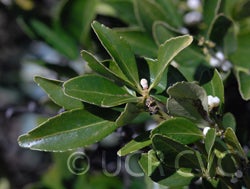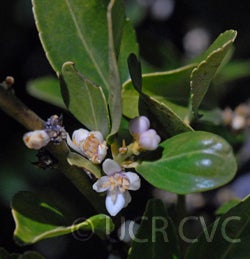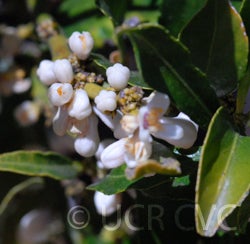New Guinea wild lime
CRC 3782
PI 539743
Source
Received as seed from D.J. Hutchinson, Orlando, Florida, 1976.
Parentage/origins
Parents unknown.
Rootstocks of accession
Carrizo citrange, C-35 citrange
Season of ripeness at Riverside
December to January
Notes and observations
Seed from Australia and New Guinea. Some dieback, especially on north, possibly due to wind.
Description from The Citrus Industry Vol. 1 (1967)
"The original description reads as follows: "Branchlets angular, soon becoming terete, apparently quite glabrous; axillary spines erecto-patent, about 2 lines long on the specimen seen. Leaves rhomboid-lanceolate, 1 1/2 to 2 1/2 in. long, 5 to 11 lines broad, deeply emarginate and the margins crenulate for 2/3 the way down; primary nerves rather numerous and very oblique, the intermediate ones and reticulate veins rather prominent. Petioles light colored, 2 to 3 in. long, very narrowly winged. (No flowers collected.) Fruit axillary on a stout peduncle, 1 1/2 lines long, globose, about 3/4 in. diam., oil glands concave, crowded, rind thin, cells 6. This species seems to be nearly allied to C. Medica, var. aruensis, Warbg., Engl., in Bot. Jahrb., 1891, page 340."
A twig of the type collection sent to Swingle by Bailey shows characters as follows: Twigs 30 cm long, 2 mm diam. at base, with very slender terminal twigs only 0.5-1 mm diam., internodes 1-2.5 cm long (rarely 5 mm on the slenderest lateral twigs), slightly angled at first but soon cylindrical, minutely puberulous at first but apparently soon glabrescent; leaves elongate-elliptical, leaf blades 4-6 X 1-1.8 cm, coarsely but shallowly crenulate-serrate, bluntly rounded at apex and often slightly emarginate, bases cuneate, subentire, lateral veins 10-12, connected by numerous smaller subparallel reticulating veinlets; petioles subulate, very short, 2-3 mm long, 0.5 mm thick, 0.8-1 mm wide, articulated with the leaf blade, with slightly depressed channel on the upper side bordered along the upper half by a slightly crenulate membrane (in drying, sometimes curved upward and making a nearly closed channel), sparingly and minutely puberulous on the upper side and on the margins.
The small globular fruits, the elongate-elliptical, crenulate leaves, and the narrowly subcrenulate-margined, very short petioles separate this New Guinea species very clearly from the other species of Microcitrus. This is the only species of the genus outside of Australia, and it occurs nearly a thousand miles away from M. garrowayi, the Australian species of Microcitrus growing nearest to New Guinea.
The fruits are small, globose, with six segments. Bailey's description, however, says nothing concerning the character of the pulp-vesicles, if any! The petioles differ from those of the other species of Microcitrus in having a very narrowly crenulate margin or wing. The veins are numerous, making only a small angle (35° to 50°) with the midrib, and soon branch, forming a reticulation of veinlets not unlike those of M. garrowayi, although the latter species has smaller leaves with fewer veins. The ultimate twigs, especially the short lateral branchlets, are remarkably slender, the smallest lateral twigs being 1 to 1.5 mm or even only 0.5 to 0.8 mm in diameter."
Availability
Not commercially available in California.
USDA Germplasm Resources Information Network page for Microcitrus warburgiana (CRC 3782)


